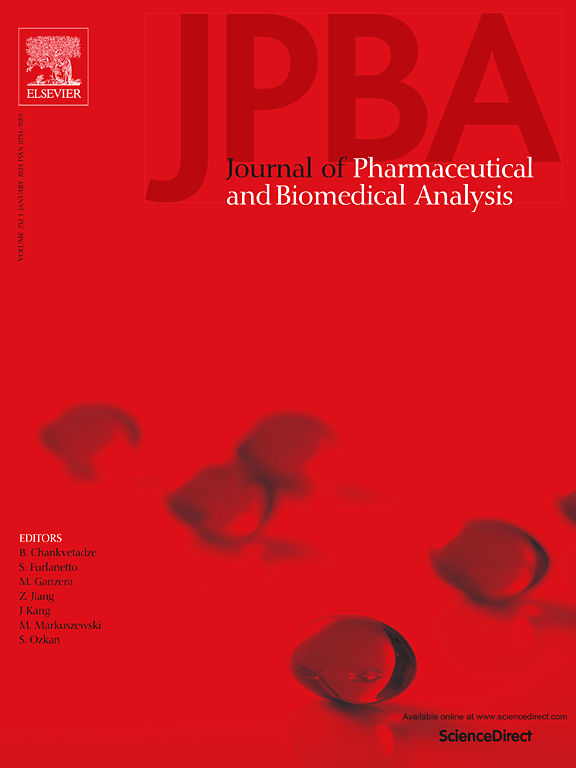Evaluation of protein impurities in Ademetionine 1,4-Butanedisulfonate
IF 3.1
3区 医学
Q2 CHEMISTRY, ANALYTICAL
Journal of pharmaceutical and biomedical analysis
Pub Date : 2024-11-04
DOI:10.1016/j.jpba.2024.116560
引用次数: 0
Abstract
Ademetionine 1,4-Butanedisulfonate (SAMe) is widely used as a prescription drug to treat cholestasis associated with liver disease, and is also used to treat depression, Alzheimer's disease and other diseases. Currently, the main way to produce SAMe is by fermentation of S-adenosylmethionine synthetase(SAMS). However, during the fermentation process, host cells produce contaminants unrelated to the treatment. Among them, host cell protein (HCP), which is co-purified with the drug, is the main impurity in the production process. HCP-induced antigenic reactions can lead to allergies or other adverse reactions and affect drug quality, efficacy, and safety. Enzyme-linked immunosorbent assay (ELISA) and mass spectrometry (MS) are currently used as the main analytical methods for measuring HCP. The ELISA method may ignore some HCPs with low immunogenicity, while mass spectrometry is primarily employed for the characterization of proteomes. Orthogonal methods can more effectively evaluate impurities in drugs. In this study, ELISA was initially utilized to quantify the content of Saccharomyces cerevisiae host protein in 11 batches of SAMe active pharmaceutical ingredient (API) from two suppliers, then the above APIs were qualitatively analyzed by MS method. Following the identification of surrogate peptide of SAMS, an Ultra Performance Liquid Chromatography-Tandem Mass Spectrometry(UPLC-MS/MS)method was established and validated, the SAMS protein residues in 11 batches of samples were subsequently determined. The results demonstrated that the levels of Saccharomyces cerevisiae host protein and SAMS in the samples were both low, with values below 20 ppm and 1.19 ppm, respectively. The qualitative results also indicate that the types of peptide residues in the samples are more diverse than those of protein residues. Furthermore, residues of proteins and peptides can be detected in all samples, which underscores the importance of evaluating the HCP in API. This study employs a range of complementary detection methods to conduct a comprehensive and sensitive evaluation of total HCP and specific proteins in drugs, thereby guiding more informed assessments of the risks posed by HCP impurities in raw materials during pharmaceutical processes.
评估 1,4-丁二磺酸阿德米汀宁中的蛋白质杂质。
腺苷蛋氨酸 1,4-丁二磺酸盐(SAMe)作为一种处方药被广泛用于治疗与肝病有关的胆汁淤积症,还可用于治疗抑郁症、老年痴呆症和其他疾病。目前,生产 SAMe 的主要方法是 S-腺苷蛋氨酸合成酶(SAMS)发酵法。然而,在发酵过程中,宿主细胞会产生与处理无关的污染物。其中,与药物共同纯化的宿主细胞蛋白(HCP)是生产过程中的主要杂质。HCP 引起的抗原反应会导致过敏或其他不良反应,影响药物的质量、疗效和安全性。酶联免疫吸附法(ELISA)和质谱法(MS)是目前测量 HCP 的主要分析方法。酶联免疫吸附法可能会忽略一些免疫原性低的 HCP,而质谱法主要用于表征蛋白质组。正交方法能更有效地评估药物中的杂质。本研究首先利用酶联免疫吸附法对两家供应商提供的 11 批 SAMe 原料药中的酵母宿主蛋白含量进行了定量分析,然后利用质谱法对上述原料药进行了定性分析。在鉴定出SAMS的替代肽后,建立并验证了超高效液相色谱-串联质谱(UPLC-MS/MS)方法,随后测定了11批次样品中SAMS蛋白的残留量。结果表明,样品中的酿酒酵母宿主蛋白和 SAMS 含量都很低,分别低于 20 ppm 和 1.19 ppm。定性结果还表明,与蛋白质残基相比,样品中的肽残基类型更为多样。此外,所有样品中都能检测到蛋白质和肽的残留物,这突出了评估原料药中 HCP 的重要性。本研究采用了一系列互补检测方法,对药物中的总 HCP 和特定蛋白质进行了全面而灵敏的评估,从而指导对制药过程中原料中 HCP 杂质带来的风险进行更明智的评估。
本文章由计算机程序翻译,如有差异,请以英文原文为准。
求助全文
约1分钟内获得全文
求助全文
来源期刊
CiteScore
6.70
自引率
5.90%
发文量
588
审稿时长
37 days
期刊介绍:
This journal is an international medium directed towards the needs of academic, clinical, government and industrial analysis by publishing original research reports and critical reviews on pharmaceutical and biomedical analysis. It covers the interdisciplinary aspects of analysis in the pharmaceutical, biomedical and clinical sciences, including developments in analytical methodology, instrumentation, computation and interpretation. Submissions on novel applications focusing on drug purity and stability studies, pharmacokinetics, therapeutic monitoring, metabolic profiling; drug-related aspects of analytical biochemistry and forensic toxicology; quality assurance in the pharmaceutical industry are also welcome.
Studies from areas of well established and poorly selective methods, such as UV-VIS spectrophotometry (including derivative and multi-wavelength measurements), basic electroanalytical (potentiometric, polarographic and voltammetric) methods, fluorimetry, flow-injection analysis, etc. are accepted for publication in exceptional cases only, if a unique and substantial advantage over presently known systems is demonstrated. The same applies to the assay of simple drug formulations by any kind of methods and the determination of drugs in biological samples based merely on spiked samples. Drug purity/stability studies should contain information on the structure elucidation of the impurities/degradants.

 求助内容:
求助内容: 应助结果提醒方式:
应助结果提醒方式:


